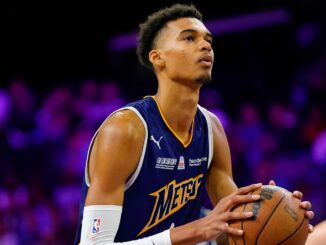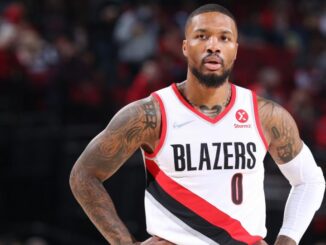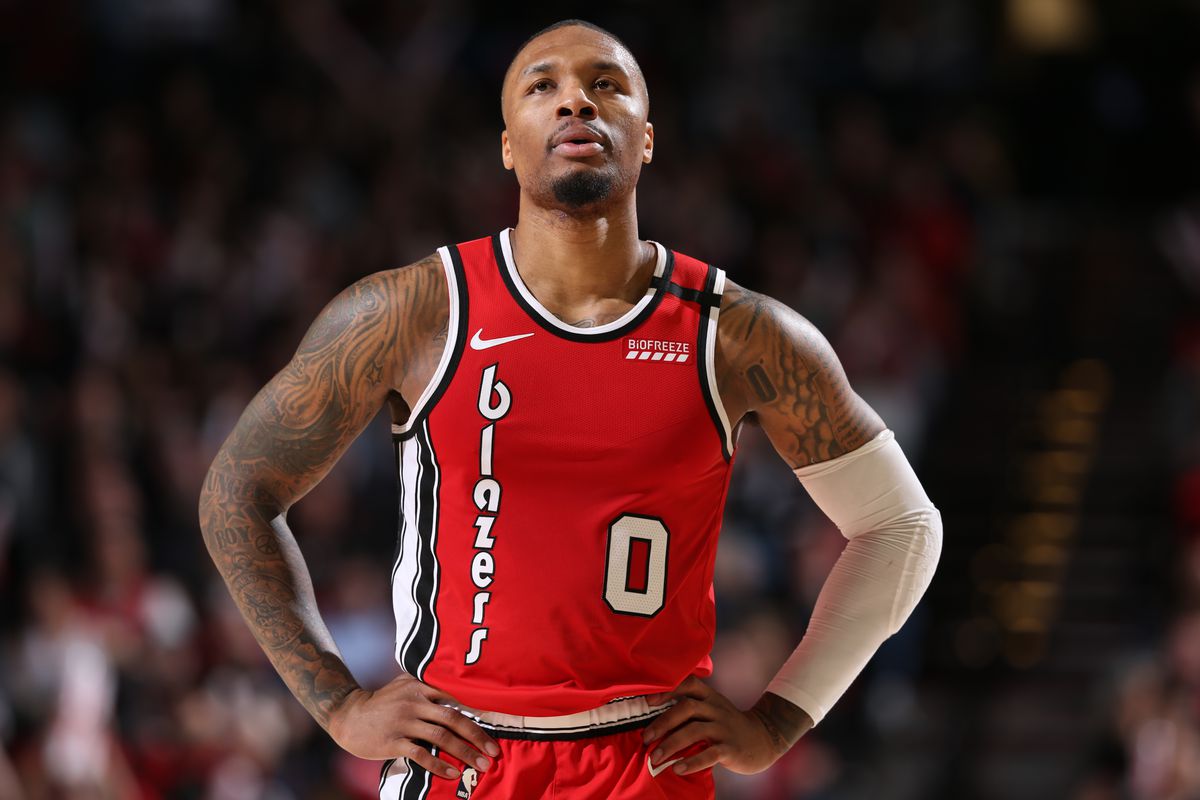
As we approach the final turn of our all-time Portland Trail Blazers player rankings, we have one final stretch … before the final stretch.
In today’s installment, Nos. 20-11 feature some serious gems. From Geoff Petrie to CJ McCollum—and a certain hometown hero—we’re about to hit players who had pivotal roles during some of the franchise’s most consequential seasons.
*Check out Part 1 of OSN’s All-Time Trail Blazers Player Ranking to review our complete voting method.
Portland Trail Blazers All-Time Top 50 Player Rankings
Nos. 50-41
50. Robin Lopez, C
49. Dave Twardzik, PG
48. Joel Przybilla, C
47. Kenny Carr, PF
46. Kermit Washington, PF
45. Tom Owens, C/PF
44. Sam Bowie, C
43. Dale Davis, C
42. Steve Johnson, C
41. Steve Blake, PG
Nos. 40-31
40. Billy Ray Bates, SG
39. Kenny Anderson, PG
38. Isaiah Rider, SG
37. Steve Smith, SG
36. Danny Ainge, G
35. Jusuf Nurkić, C
34. Anfernee Simons, SG
33. Bonzi Wells, SG/SF
32. Andre Miller, PG
31. Wesley Matthews, SG
Nos. 30-21
30. Lloyd Neal, PF/C
29. Bob Gross, SF
28. Calvin Natt, SF/PF
27. Brian Grant, PF/C
26. Larry Steele, SG/SF
25. Nicolas Batum, SF
24. Mychal Thompson, C
23. Scottie Pippen, SF
22. Rod Strickland, PG
21. Lionel Hollins, PG
Nos. 21-10
*All stats are from the player’s time with the Trail Blazers, not their total career stats.
20. Damon Stoudamire, PG
Years: 1998-2005
Games Played: 529
PPG: 12.8
RPG: 3.5
APG: 5.7
SPG: 1.1
HI RK: 13
LO RK: 39
In 1998, the Blazers had a productive, unselfish point guard in Kenny Anderson. He was an excellent set-up man for newcomer Rasheed Wallace, and quite frankly, he was fun to watch.
The only problem was that general manager Bob Whittsit had eyes for hometown kid and 1995 Rookie of the Year Damon Stoudamire. And what Trader Bob wanted, Trader Bob often found a way to get.
The “hometown kid” aspect of Stoudamire’s legacy matters. If you read his “Letter To My Younger Self” in the Players’ Tribune, you know what playing for this team and in this city meant to him. Portland’s “original Dame” really was “Rip City” personified. As OSN’s Casey Mabbott puts it: “Having the next great point guard was a great thing on its own, but for that dude to be a local kid just made it extra special.”
Mabbott also hits it square on the head when it comes to Damon’s legacy, both on and off the court.
“‘Mighty Mouse’ was a hero on and off the court, and his skills were exceeded only by his will to win,” Mabbott says. “He had to keep a bunch of wacky personalities in check while competing with two of the greatest dynasties of all time, and he did it in style.
“Damon could have been from anywhere, and he would have been loved here. But being a local kid who became a hero to local kids? He was beloved.”
19. Sidney Wicks, PF
Years: 1971-1976
Games Played: 466
PPG: 23.3
RPG: 10.3
APG: 4.1
SPG: 1.2
BPG: 0.8
HI RK: 15
LO RK: 26
Sidney Wicks’ reputation isn’t the best among our top 50 players, as he became a legendary stat-chaser during Portland’s first-ever struggle-bus era.
It didn’t help, either, that Portland’s best season followed immediately after replacing Wicks with Maurice Lucas at power forward—which, of course, was the 1977 championship run.
Wicks was a player who put up serious numbers, even if they often amounted to potato chip stats. He’s one of only eight players in team history to average a double-double to this day, and he set a team record in 1975 with 27 rebounds in a game—a record that stood until Enes Kanter grabbed 30 boards against the Detroit Pistons in 2021.
As OSN’s Arran Gimba puts it: “Rookie of the Year AND All-Star in his first four years in the NBA, Sidney Wicks was influential in the team’s early success as a franchise. He excelled in scoring, rebounding, and defense. He really was the total package.”
18. Kevin Duckworth, C
Years: 1986-1993
Games Played: 527
PPG: 13.6
RPG: 6.3
APG: 0.8
BPG: 0.5
HI RK: 11
LO RK: 24
I haven’t shared too many personal memories up to this point in our project, but as I think about Kevin Duckworth, I can’t help but break protocol because everyone I come across seems to have a memory of Duck.
For starters and full awareness, I’m a little too young to remember watching Duckworth in live action. Don’t get me wrong; he was the first “KD” in my life, and by the time I was an eight-year-old kid studying “ancient history” in 1997—like the 1992 Finals run through my dad’s trading cards, recorded VHS tapes and “old” Sports Illustrated magazines—I quickly learned what he meant to the community.
The community part was obvious, as his house (the biggest house I’d ever seen in real life) looked down on the field where I played Little League baseball. I’ve also met folks who’ve recalled Duck frequenting their local watering holes back when he’d end a long day at the construction site.
On the court, Duckworth was a pivotal part of a team that went to multiple Finals and was an All-Star.
And yet, anyone I encounter who has a Duck story rarely tells me anything about basketball. He was a part of the community, which means something.
17. Zach Randolph, PF/C
Years: 2001-2007
Games Played: 387
PPG: 16.0
RPG: 7.7
APG: 1.5
HI RK: 12
LO RK: 27
Zach Randolph’s time in Portland was a mixed bag of dominant play and controversy. It took him just three seasons to become a full-time starter and double-double machine. But his early days also featured legal problems and tiffs with teammates that were impossible to ignore.
Today, Randolph’s reputation is largely recovered. He’s revered in Memphis, where he played eight of his final nine NBA seasons and became a real community member. Blazers fans, too, can look back and remember better times now that they’re further removed from the ruckus.
Of course, one of the interesting parts of these rankings isn’t just how the player performed with the Blazers but who he outranks. It’s fascinating to see Randolph come in one spot higher (with just two voter points) ahead of Kevin Duckworth.
Is that the right spot for Z-Bo? Let’s turn to OSN’s Ben McCarty:
“This is a tough call. From a raw statistical standpoint, Randolph had a better career in almost every respect. He played almost twice as many games in his career as Duck and finished with higher average totals in almost every category. However, he also played in an era not fondly remembered in Blazers history, whereas Kevin Duckworth played for some of the best Blazers teams in franchise history.
“ZBo thrived in tough circumstances, earning a well-deserved top 20 ranking. Duckworth was a key piece on some incredible teams. This is a fair spot for them both.”
16. Kiki Vandeweghe, SF/PF
Years: 1984-1989
Games Played: 285
PPG: 23.5
RPG: 2.9
APG: 2.2
SPG: 1.2
HI RK: 13
LO RK: 26
If you’re looking for an absolute bucket, look no further than Kiki Vandeweghe.
When the Blazers traded for Vandewegh in 1984, they knew what they were getting—and they knew why they were getting him.
Portland needed a scorer. Vandewegh was coming off a campaign in which he dropped nearly 30 points per contest with the Denver Nuggets, and at 25 years old, his potential looked stronger than anyone Portland gave up in the deal. (This was an absolute haul, by the way, including Calvin Natt, Fat Lever, Wayne Cooper, and multiple draft picks.)
Of course, the return proved worth the haul.
Vendewegh was a consistent 20-point-per-game scorer, even alongside Clyde Drexler and Co. Although he rarely shot threes, he did knock down 40.8 percent of his attempts.
Not everyone in our rankings valued Kiki’s scoring as highly as others, though. To share his view, here’s OSN’s Jared Wright:
“Kiki may have never quite reached the heights of his Denver heyday in Portland (the Nuggets traded him hereafter consecutive All-Star seasons, and he never made the team again), but his all-offense, no-defense style was very proper for the 1980s as a whole.
“Kiki fell off a cliff production-wise after younger and more athletic forwards like Pippen and Dennis Rodman matured. I’m struggling not to say the quiet part out loud.”
To this day, the 6’8” baller from West Germany sits No. 2 among all-time Trail Blazers scorers. He trails only Damian Lillard (25.2 PPG), and he did it while hitting…get this…2,298 fewer three-pointers.
15. Buck Williams, PF
Years: 1989-1996
Games Played: 557
PPG: 10.2
RPG: 8.7
BPG: 0.6
HI RK: 11
LO RK: 26
In 1989, the Blazers moved on from Sam Bowie by trading him to the New Jersey Nersey Nets for Buck Williams. Buck had already racked up plenty of accolades: Rookie of the Year in 1982; he was a three-time All-Star and an All-Defense 2nd Team member in 1988.
As it turned out, the 6’8” power forward was more than just an accomplished piece. He was the final piece to Portland’s championship puzzle.
As OSN’s Nick Bartlett puts it: “Buck Williams is perfect at the No. 15 spot because he wouldn’t want himself to be any higher. Williams was a quintessential hard-nosed player who would willingly play defense and rebound. He helped transform the Clyde Drexler-era Blazers into championship contenders with his spirit.”
And that—combined with his talent and true compassion—is why Rip City still loves him.
14. Jim Paxson, SG/PG
Years: 1979-1988
Games Played: 627
PPG: 16.0
RPG: 2.3
APG: 3.2
SPG: 1.4
HI RK: 11
LO RK: 22
Jim Paxson and his version of the Trail Blazers didn’t shoot a lot of threes. Paxson sits just 38th all-time in Trail Blazers three-point attempts and slips to 56th when looking at makes. Yet, he owns the No. 21 points-per-game average in franchise history at 16.0. And he was the first player in franchise history to eclipse 10,000 points—just the 30th NBA player ever to hit that mark at the time.
At 6’6”, Paxson had great size for a shooting guard. He used that size well, but he also made a career out of moving without the ball and using his shiftiness to read angles and score both at the rim and beyond the foul line.
That bag of tricks earned Paxson two All-Star appearances and an All-NBA Second Team honor in Portland. And when you combine that with his longevity (No. 7 all-time in Trail Blazers games played), he deservingly earns a top-15 spot on our Top 50 Rankings.
13. CJ McCollum, SG/PG
Years: 2013-2022
Games Played: 564
PPG: 19.0
RPG: 3.4
APG: 3.4
SPG: 0.9
3PT%: 39.6
HI RK: 5
LO RK: 20
CJ McCollum entered the league in 2013, best known for his legendary Duke takedown during March Madness the year prior. His 30 points led No. 15 Lehigh over No. 2 Duke, and that’s why fans were so intrigued by a small-school, undersized guard.
Scouts, of course, had questions. Would his scoring translate? Was he crafty enough to take advantage of NBA defenses without a more traditional NBA frame?
Neil Olshey decided he wasn’t concerned, taking CJ 10th overall just a year after landing Damian Lillard. And that, of course, is a big reason he never traded away his prized pick.
CJ went on to become a top-10 franchise scorer (No. 8) who’s also top-10 in total assists (No. 8) and games played (No. 9). His shooting numbers? They’re elite. He finished his Portland career No. 2 in both three-pointers made and three-pointers attempted, and his 39.6 three-point percentage lands him fourth among players with a minimum of 200 games played.
Of course, as good as the vibes were watching CJ iso score off the dribble—whether on a random Tuesday night against the Raptors or a Game 7 win over the Denver Nuggets—the Blazers hit their ceiling with the Lillard-McCollum backcourt. After Olshey’s firing in 2012, it was only a matter of time before Joe Cronin made the move his predecessor refused to make.
As we all know, McCollum was traded to the New Orleans Pelicans after playing more than 500 regular season games next to Lillard. He still makes his wine in the Willamette Valley and gets the second-biggest reception among former Blazers to return each year. As I said with Wes Matthews in the previous installment of this series, He’s always welcome home.
12. Arvydas Sabonis, C
Years: 1995-2003
Games Played: 470
PPG: 110.0
RPG: 7.3
APG: 2.1
SPG: 0.1
BPG: 1.1
3PT%: 32.8
Hi RK: 7
Lo RK: 17
You can’t talk about Arvydas Sabonis without acknowledging his European basketball legacy. The man known as a 7’3” Larry Bird had all the tricks in his bag we saw in Portland. Still, he was swift on his feet and commanded defenses en route to winning championship after championship in the 1980s and 90s—all while becoming one of FIBA’s 50 Greatest Players of All-Time by 1991.
The truth is, his story is far too fascinating to cram into a few paragraphs here, so I won’t try. Instead, I’ll encourage you to find articles and videos looking back on his pre-NBA days (after finishing this story, of course.)
During his time in Portland, Sabas left a lasting impression. He was far from nimble, yet he played with more grace than anyone on the court. His guard-like instincts never left after injuries slowed him down, making behind-the-back passes and over-the-head dump-offs staples of his game until the end.
For all the talk about his skill, though, Sabonis knew how to use his size. Enemy No. 1 during his Rip City days was Shaquille O’Neal, whose combination of size and quickness off the left-shoulder spin was unfair.
Sabonis never conquered Mount Shaq in the end, but really, no one ever did. The Blazers’ big man was always a fan favorite. It’s fun today watching Sabonis 2.0 carry on the legacy with the Sacramento Kings.
11. Geoff Petrie, SG/PG
Years: 1970-1976
Games Played: 312
PPG: 121.8
RPG: 2.8
APG: 4.6
SPG: 1.0
HI RK: 7
LO RK: 17
Geoff Petrie was the No. 8 pick in 1970, but while that piece of trivia may escape most NBA fans, Rip City won’t soon forget the Trail Blazers’ first-ever draft pick.
Petrie, the “Original Trail Blazer,” set the tone for the new franchise with 24.8 points, 3.4 rebounds, and 4.8 assists in his rookie season. He was an All-Star and the league’s Rookie of the Year in 1971, and he was a long-range shooter we now wish would’ve played in a three-point era.
Unfortunately for Petrie, that’s not the only “what if?” attached to his name. After multiple years of high-octane scoring—including a 51-point performance that stood as Portland’s single-game record until Damon Stoudamire recorded 54 points in 2005—the guard became one of the first in a long line of Trail Blazers to lose his speed and accumulate injuries.
Portland ended up trading Petrie in 1976 to the Atlanta Hawks for their No. 2 pick in the draft. That pick? Well, that’s another piece of trivia NBA fans might forget. But Blazers fans will always remember who that pick became: “The Enforcer”—Maurice Lucas—who we’ll cover next time in our Top 10 Trail Blazers of All-Time.



